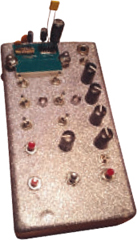READER INPUT

Raygun Circuits, Free Beer, and the Quest for Long-Lasting 3D Printers
IN RESPONSE TO THE “RAYGUN VECTOR WEAPON”
PROJECT FROM VOLUME 35
» I bought the Vector Weapon Kit from the Maker Shed for my 6-year-old son Desmond as a Christmas present. This was the first real electronics build we’ve done together. It was a good opportunity to show him a little bit about soldering and how some of the elements in the circuit work. It’s really rewarding to do this kind of project with Desmond, as it gives us a fun way to spend time together, a creative way for me to teach him things, and of course, results in a unique toy that will hold memories we will both have for a lifetime.
—Genji Siraisi, New York City, N.Y.
+ Read more about their build and check out their fun videos: makezine.com/go/genji

» I had so much fun with this [Raygun Vector Weapon] circuit! I made an instrument with it and a modified version of Eric Archer’s Mini Space Rocker circuit (vimeo.com/85130857). Right now it’s a manually operated four-voice drum synth. I plan to add an external sequencer and a piezo trigger for fills and live play. Please give us more cool lo-fi audio projects. I got into DIY synths and noise circuits a few years ago after Collin Cunningham did a piece about the Atari Punk Console. After a quick trip to RadioShack I had a fun noise toy and I was hooked. Thanks MAKE!
—Chuck Stephens, Tampa, Fla.
IN RESPONSE TO OUR MAKE: ULTIMATE GUIDE TO 3D PRINTING 2014:
» I bought a printer after reading through the excellent 2013 version of the 3D printing guide — good advice and worth every penny. After several months of experience with the technology, here is what I would find useful: a side-by-side comparison of printers put through extended rigorous production. Simply running a test print off a model that is new and has been calibrated by the supplier is not adequate to evaluate how good a design really is. How long before each extruder clogged? How does each printer do running several 6 hour+ print jobs? How many failed prints did you have? How does each printer hold up after extended daily use for 30+ days? What parts shake loose, and what parts are inadequate for constant duty? My hope is to get another printer in the next year or so, but in my experience the $2,500 printers break down and suffer from poor design (especially in the filament handling) just like the $300 printers do. This industry will remain a tinkerer’s playhouse so long as the large-print success rate is below 95% with printers more than 30 days old.
—Brian Cooper, Denver, Colo.
DIGITAL FABRICATION EDITOR ANNA KAZIUNAS FRANCE RESPONDS:
» Thanks for your feedback! Your comments raise some excellent points. We understand that long-term testing is critical to making hardware recommendations and evaluating performance. Future testing will be focused on exploring exactly those issues that you mention. We will also be increasing the frequency of our testing, as new printers are being developed at an astonishing rate. Look for them both online and in MAKE magazine shortly.
» What does “Free as in beer” mean? I have only recently discovered MAKE magazine, and am now reading my second issue. (I love them!) Both issues have contained the phrase. I live in Colorado, where beer costs money, especially the fancy microbrews. So what gives?
TECHNICAL EDITOR SEAN RAGAN RESPONDS:
» Great question! “Free as in beer” is a phrase that originates in the open software movement. It’s used to make a point about the meaning of the word “free,” which, especially when it comes to software, represents two very distinct ideas that often need to be separated for clarity. There’s “free,” in the sense of something that is given away (“free as in beer”), and there’s “free” in the sense of freedom (“free as in speech”). Some software is given away for free but is nonetheless closed-source and proprietary, making it “free as in beer” but NOT “free as in speech.” ![]()


